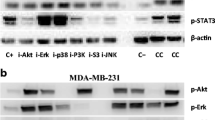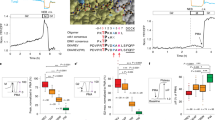Abstract
Introduction
CXCR4 and epidermal growth factor receptor (EGFR) represent two major families of receptors, G-protein coupled receptors and receptor tyrosine kinases, with central functions in cancer. While utilizing different upstream signaling molecules, both CXCR4 and EGFR activate kinases ERK and Akt, although single-cell activation of these kinases is markedly heterogeneous. One hypothesis regarding the origin of signaling heterogeneity proposes that intercellular variations arise from differences in pre-existing intracellular states set by extrinsic noise. While pre-existing cell states vary among cells, each pre-existing state defines deterministic signaling outputs to downstream effectors. Understanding causes of signaling heterogeneity will inform treatment of cancers with drugs targeting drivers of oncogenic signaling.
Methods
We built a single-cell computational model to predict Akt and ERK responses to CXCR4- and EGFR-mediated stimulation. We investigated signaling heterogeneity through these receptors and tested model predictions using quantitative, live-cell time-lapse imaging.
Results
We show that the pre-existing cell state predicts single-cell signaling through both CXCR4 and EGFR. Computational modeling reveals that the same set of pre-existing cell states explains signaling heterogeneity through both EGFR and CXCR4 at multiple doses of ligands and in two different breast cancer cell lines. The model also predicts how phosphatidylinositol-3-kinase (PI3K) targeted therapies potentiate ERK signaling in certain breast cancer cells and that low level, combined inhibition of MEK and PI3K ablates potentiated ERK signaling.
Conclusions
Our data demonstrate that a conserved motif exists for EGFR and CXCR4 signaling and suggest potential clinical utility of the computational model to optimize therapy.








Similar content being viewed by others
References
Altschuler, S. J., and L. F. Wu. Cellular heterogeneity: do differences make a difference? Cell 141:559–563, 2010.
Ballou, L. M., and R. Z. Lin. Rapamycin and mTOR kinase inhibitors. J. Chem. Biol. 1:27–36, 2008.
Blower, S. M., and H. Dowlatabadi. Sensitivity and uncertainty analysis of complex models of disease transmission: an HIV model, as an example. Int. Stat. Rev. 62:229–243, 1994.
Burke, P., K. Schooler, and H. S. Wiley. Regulation of epidermal growth factor receptor signaling by endocytosis and intracellular trafficking. Mol. Biol. Cell 12:1897–1910, 2001.
Chang, S. L., S. P. Cavnar, S. Takayama, G. D. Luker, and J. J. Linderman. Cell, isoform, and environment factors shape gradients and modulate chemotaxis. PLoS ONE 10:e0123450, 2015.
Cheng, Y., et al. CXCL12/SDF-1α induces migration via SRC-mediated CXCR4-EGFR cross-talk in gastric cancer cells. Oncol. Lett. 14:2103–2110, 2017.
Choi, Y. H., M. D. Burdick, B. A. Strieter, B. Mehrad, and R. M. Strieter. CXCR4, but not CXCR7, discriminates metastatic behavior in non-small cell lung cancer cells. Mol. Cancer Res. 12:38–47, 2014.
Cintas, C., and J. Guillermet-Guibert. Heterogeneity of phosphatidylinositol-3-kinase (PI3K)/AKT/mammalian target of rapamycin activation in cancer: is PI3K isoform specificity important? Front. Oncol. 7:330, 2018.
Coggins, N. L., et al. CXCR7 controls competition for recruitment of β-arrestin 2 in cells expressing both CXCR4 and CXCR7. PLoS ONE 9:e98328, 2014.
Cojoc, M., C. Peitzsch, L. Polishchuk, G. Telegeev, and A. Dubrovska. Emerging targets in cancer management: role of the CXCL12/CXCR4 axis. Onco. Targets. Ther. 6:1347–1361, 2013.
Dawson, J. P., M. B. Berger, C. Lin, J. Schlessinger, M. A. Lemmon, and K. M. Ferguson. Epidermal growth factor receptor dimerization and activation require ligand-induced conformational changes in the dimer interface. Mol. Cell. Biol. 25:7734–7742, 2005.
DeNies, M. S., L. K. Rosselli-Murai, S. Schnell, and A. P. Liu. Clathrin heavy chain knockdown impacts CXCR4 signaling and post-translational modification. Front. Cell Dev. Biol. 7:1–11, 2019.
Domanska, U. M., et al. A review on CXCR4/CXCL12 axis in oncology: no place to hide. Eur. J. Cancer 49:219–230, 2013.
English, E. J., S. A. Mahn, and A. Marchese. Endocytosis is required for CXC chemokine receptor type 4 (CXCR4)-mediated Akt activation and antiapoptotic signaling. J. Biol. Chem. 293:11470–11480, 2018.
Faes, S., N. Demartines, and O. Dormond. Resistance to mTORC1 inhibitors in cancer therapy: from kinase mutations to intratumoral heterogeneity of kinase activity. Oxid. Med. Cell. Longev. 2017:1726078, 2017.
Gaudet, S., and K. Miller-Jensen. Redefining signaling pathways with an expanding single-cell toolbox. Trends Biotechnol. 34:458–469, 2016.
Gerdes, M. J., A. Sood, C. Sevinsky, A. D. Pris, M. I. Zavodszky, and F. Ginty. Emerging understanding of multiscale tumor heterogeneity. Front. Oncol. 4:1–12, 2014.
Harwood, F. C., et al. ETV7 is an essential component of a rapamycin-insensitive mTOR complex in cancer. Sci. Adv. 4:1–18, 2018.
Hendriks, B. S., L. K. Opresko, H. S. Wiley, and D. Lauffenburger. Coregulation of epidermal growth factor receptor/human epidermal growth factor receptor 2 (HER2) levels and locations: quantitative analysis of HER2 overexpression effects. Cancer Res. 63:1130–1137, 2003.
Hollestelle, A., F. Elstrodt, J. H. A. Nagel, and W. W. Kallemeijn. Phosphatidylinositol-3-OH Kinase or RAS pathway mutations in human breast cancer cell lines. Mol. Cancer Res. 5:195–201, 2007.
Iwamoto, K., Y. Shindo, and K. Takahashi. Modeling cellular noise underlying heterogeneous cell responses in the epidermal growth factor signaling pathway. PLoS Comput. Biol. 12:1–18, 2016.
Jeantet, M., et al. High intra-and inter-tumoral heterogeneity of RAS mutations in colorectal cancer. Int. J. Mol. Sci. 17:2015, 2016.
Kaschek, D., B. Hahn, D. Wrangborg, J. Karlsson, and M. Kvarnström. Heterogeneous kinetics of AKT signaling in individual cells are accounted for by variable protein concentration. Front. Physiol. 3:1–14, 2012.
Kasina, S., P. A. Scherle, C. L. Hall, and J. A. MacOska. ADAM-mediated amphiregulin shedding and EGFR transactivation. Cell Prolif. 42:799–812, 2009.
Kim, E., J. Kim, M. A. Smith, E. B. Haura, R. Alexander, and A. Anderson. Cell signaling heterogeneity is modulated by both cell-intrinsic and -extrinsic mechanisms: an integrated approach to understanding targeted therapy. PLoS Biol. 16:1–29, 2018.
Klein, P., M. A. Lemmon, I. Lax, and J. Schlessinger. On the nature of low- and high-affinity EGF receptors on living cells. PNAS 103:5735–5740, 2006.
Kohno, M., and J. Pouyssegur. Targeting the ERK signaling pathway in cancer therapy. Ann. Med. 38:200–211, 2006.
Kudo, T., et al. Live-cell measurements of kinase activity in single cells using translocation reporters. Nat. Protoc. 13:155–169, 2017.
Kuo, Y.-H., et al. dual inhibition of key proliferation signaling pathways in triple-negative breast cancer cells by a novel derivative of Taiwanin A. Mol. Cancer Ther. 16:480–493, 2017.
Lee, R. E. C., S. R. Walker, K. Savery, D. A. Frank, and S. Gaudet. Fold change of nuclear NF-κB determines TNF-induced transcription in single cells. Mol. Cell 53:867–879, 2014.
Marino, S., I. B. Hogue, C. J. Ray, and D. E. Kirschner. A methodology for performing global uncertainty and sensitivity analysis in systems biology. J. Theor. Biol. 254:178, 2009.
Mendoza, M. C., E. Emrah Er., and J. Blenis. The Ras-ERK and PI3K-mTOR pathways: cross-talk and compensation. Trends Biochem. Sci. 36:320–328, 2011.
Moelling, K., K. Schad, M. Bosse, S. Zimmermann, and M. Schweneker. Regulation of Raf-Akt cross-talk. J. Biol. Chem. 277:31099–31106, 2002.
Mosadegh, B., W. Saadi, S. J. Wang, and N. L. Jeon. Epidermal growth factor promotes breast cancer cell chemotaxis in CXCL12 gradients. Biotechnol. Bioeng. 100:1205–1213, 2008.
Nitulescu, G. M., et al. The Akt pathway in oncology therapy and beyond (Review). Int. J. Oncol. 53:2319–2331, 2018.
Ozawa, P., et al. Role of CXCL12 and CXCR4 in normal cerebellar developmentand medulloblastoma. Int. J. Cancer 138:10–13, 2014.
Pinilla-Macua, I., S. C. Watkins, and A. Sorkin. Endocytosis separates EGF receptors from endogenous fluorescently labeled HRas and diminishes receptor signaling to MAP kinases in endosomes. Proc. Natl. Acad. Sci. U. S. A. 113:2122–2127, 2016.
Posada, I. M. D., B. Lectez, F. A. Siddiqui, C. Oetken-Lindholm, M. Sharma, and D. Abankwa. Opposite feedback from mTORC1 to H-ras and K-ras4B downstream of SREBP1. Sci. Rep. 7:1–14, 2017.
Real, R., and J. M. Vargas. The probabilistic basis of Jaccard’s index of similarity. Syst. Biol. 45:380–385, 1996.
Regot, S., J. J. Hughey, B. T. Bajar, S. Carrasco, and M. W. Covert. High-sensitivity measurements of multiple kinase activities in live single cells. Cell 157:1724–1734, 2014.
Rodríguez-Nieves, J. A., S. C. Patalano, D. Almanza, M. Gharaee-Kermani, and J. A. Macoska. CXCL12/CXCR4 axis activation mediates prostate myofibroblast phenoconversion through non-canonical EGFR/MEK/ERK signaling. PLoS ONE 11:1–14, 2016.
Sarbassov, D. D., et al. Prolonged rapamycin treatment inhibits mTORC2 assembly and Akt/PKB. Mol. Cell 22:159–168, 2006.
Saxton, R. A., and D. M. Sabatini. mTOR signaling in growth, metabolism, and disease. Cell 168:960–976, 2017.
Serra, V., et al. PI3K inhibition results in enhanced HER signaling and acquired ERK dependency in HER2-overexpressing breast cancer. Oncogene 30:2547–2557, 2011.
Seshacharyulu, P., M. Ponnusamy, D. Haridas, M. Jain, A. Ganti, and S. K. Batra. Targeting the EGFR signaling pathway in cancer therapy. Expert Opin Ther Targets 16:15–31, 2012.
Shimizu, T., et al. The clinical effect of the dual-targeting strategy involving PI3K/AKT/mTOR and RAS/MEK/ERK pathways in patients with advanced cancer. Clin. Cancer Res. 18:2316–2326, 2012.
Sigismund, S., D. Avanzato, and L. Lanzetti. Emerging functions of the EGFR in cancer. Mol. Oncol. 12:3–20, 2018.
Snijder, B., and L. Pelkmans. Origins of regulated cell-to-cell variability. Nat. Rev. Mol. Cell Biol. 12:119–125, 2011.
Sobolik, T., Y. Su, S. Wells, G. D. Ayers, and R. S. Cook. CXCR4 drives the metastatic phenotype in breast cancer through induction of CXCR2 and activation of MEK and PI3K pathways. Mol. Biol. Cell 25:566, 2014.
Spencer, S. L., S. D. Cappell, F. C. Tsai, K. W. Overton, C. L. Wang, and T. Meyer. The proliferation-quiescence decision is controlled by a bifurcation in CDK2 activity at mitotic exit. Cell 155:369, 2013.
Spinosa, P. C., et al. Short-term cellular memory tunes the signaling responses of the chemokine receptor CXCR4. Sci. Signal. 12:eaaw4204, 2019.
Sumit, M., A. Jovic, R. R. Neubig, S. Takayama, and J. J. Linderman. A two-pulse cellular stimulation test elucidates variability and mechanisms in signaling pathways. Biophys. J . 116:962–973, 2019.
van Mourik, S., C. ter Braak, H. Stigter, and J. Molenaar. Prediction uncertainty assessment of a systems biology model requires a sample of the full probability distribution of its parameters. PeerJ 2:e433, 2014.
Vanlier, J., C. Tiemann, P. Hilbers, and N. van Riel. Parameter uncertainty in biochemical models described by ordinary differential equations. Math. Biosci. 246:305–314, 2013.
Wang, Y., S. Pennock, X. Chen, and Z. Wang. Endosomal signaling of epidermal growth factor receptor stimulates signal transduction pathways leading to cell survival. Mol. Cell. Biol. 22:7279–7290, 2002.
Wee, P., and Z. Wang. Epidermal growth factor receptor cell proliferation signaling pathways. Cancers (Basel). 9:1–45, 2017.
Wendel, C., et al. CXCR4/CXCL12 participate in extravasation of metastasizing breast cancer cells within the liver in a rat model. PLoS ONE 7:e30046, 2012.
Yao, J., A. Pilko, and R. Wollman. Distinct cellular states determine calcium signaling response. Mol. Syst. Biol. 12:894, 2016.
Yuan, T. L., G. Wulf, L. Burga, and L. C. Cantley. Cell-to-cell variability in PI3K protein level regulates PI3K-AKT pathway activity in cell populations. Curr. Biol. 21:173–183, 2011.
Zhang, Q., et al. NF-κB dynamics discriminate between TNF doses in single cells. Cell Syst. 5:638–645, 2017.
Acknowledgments
The authors acknowledge funding from United States National Institutes of Health Grants R01CA196018, R01CA238042, R01CA238023, R33CA225549, R37CA222563, R50CA221807, and U01CA210152. P.C.S was supported by the NIH Microfluidics in Biomedical Sciences Training Program NIBIB T32 EB005582. B.H was supported by an American Cancer Society - Michigan Cancer Research Fund Postdoctoral Fellowship, PF-18-236-01-CCG. The authors also thank Annabel Levinson for technical assistance.
Author Contributions
P.C.S, P.C.K, J.J.L, G.D.L, and K.E.L conceptualized the study. B.H and K.E.L provided reagents. P.C.S, P.C.K, and K.E.L performed experiments and analyzed data. P.C.S, P.C.K., J.J.L, G.D.L, and K.E.L wrote the manuscript. All authors edited the manuscript before submission.
Conflict of interest
G.D.L receives research funding and serves on the scientific advisory board for Polyphor.
Author information
Authors and Affiliations
Corresponding authors
Additional information
Associate Editor Michael R. King oversaw the review of this article.
Publisher's Note
Springer Nature remains neutral with regard to jurisdictional claims in published maps and institutional affiliations.
Electronic supplementary material
Below is the link to the electronic supplementary material.
Rights and permissions
About this article
Cite this article
Spinosa, P.C., Kinnunen, P.C., Humphries, B.A. et al. Pre-existing Cell States Control Heterogeneity of Both EGFR and CXCR4 Signaling. Cel. Mol. Bioeng. 14, 49–64 (2021). https://doi.org/10.1007/s12195-020-00640-1
Received:
Accepted:
Published:
Issue Date:
DOI: https://doi.org/10.1007/s12195-020-00640-1




